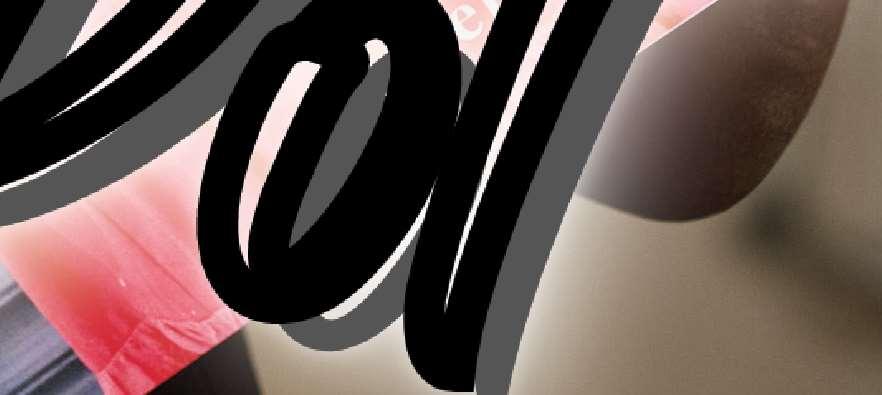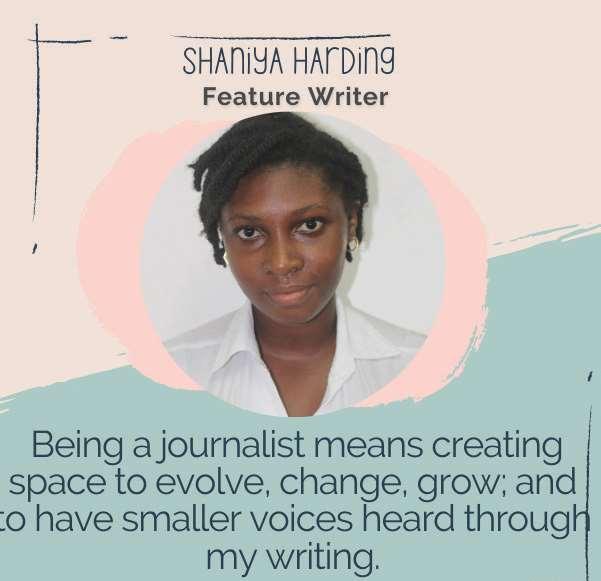ByMichelOutridge
ASwecelebrateAgricultureMonth2024withthe theme“TransformingTomorrow:Championing FoodSecuritythroughInnovationandTechnology”, wewillbefeaturingsomeof ourlocalswhohavemade
ourlocalsectorandfarther
Thisweek,wearefeaturingPrincessCosbertwith herbrand“TheEssenceof Herbs”,whichshestartedin 2015.Asacancersurvivor, shehadavisiontocraftnaturallydeliciousandethically sourcedherbsandspicesinto teasandotherproductsto satisfytheGuyanamarket.
Thesmallcompanyhas grownovertheyearsandhas expandeditsproductlineto includedietarysupplements, skincare,haircare,hygiene andfacialproducts,among otheritems.TheEssenceof Herbsproductshavereceived enthusiasticreviewsandare onsaleacrossGuyana.
Cosbertdidnotknowthat herlife-threateningillness wouldhaveempoweredher tobecomeanagro-processor ofall-naturalproductsinthe formofteadrops/gummies andorganichairandskin careproducts,whichhave significantnutritionaland
The38-year-oldtoldthe
PepperpotMagazinethat sheisacancersurvivorand creditshersurvivaltoherbal treatmentswhichwereadministeredbyherownfather, whohassincepassedaway. Cosbertlosthermotherto cancer,and,onherdeathbed, sheaskedPrincesstohave herselfcheckedoutsince shefeltthatsomethingwas wrongwithherhealth.She hadbeenill,andhermother washercaregiver.Onthe brinkofdeath,10yearsago, aftershewasdiagnosedwith cancer,Cosbertoptedtoutiliseherbalmedicine,which significantlyimprovedher healthandgaveheranew
leaseonlife.
Havingmadea fullrecovery,she wantedtoundertake anagro-processing ventureinnatural, herbalproducts.Aftersurvivingcancerwiththehelpof herbaltreatments, Cosbertwanted topromoteorganic,herbalproducts whichcanbebene-steadofexpensive medicalcare.Sheis atestimonyofthe powerofnatural productsandwhat
abletins.
Theproductwillbeat Massy,Turkeyen,EastCoast Demerara,theGuyanaShop, RobbandAlexanderStreets, andGeorgetown,following itslaunchlaterthismonth.
Beforeshewasdiagnosed withcancer,Cosbertwasa hairdresserandanailtechni-suebecominganagro-processorviaherownlineof productsunderthemoniker, “EssenceofHerbs”.
“Medicaltreatmentswere expensive,andwhenIwas notgettingbetter,Ioptedto listentomyfather,whogave meherbalmedicineswhich
Thenewlineoftea drops(gummies)will bereleasedintothe localmarketsoon
theycandoforthebodyto promotehealth.
Shestartedasmall agro-processingbusiness viaaminifactoryinfront ofherhouseatFarm,East BankDemerara,eightyears ago,producingorganictea makingit.
Cosberthasembarkedon anewventure,whichisproducingteadropsinagummy formthatcanbeusedinhot waterasteawithoutmilk orsugarandissuitablefor diabetes.
Shereportedthatthe herbalteadropscomeinsix inclear(see-through)reus-
improvedmy healthover time,andI overcame cancerandbecamehealthy again,”she said.
Cosbert relatedthat thelife-changingexperienceopened hereyesto themulti-facetedbenefits ofherbsand organicproducts,andshe wantedtoproduceproducts thatwould haveapositiveimpacton health.
Today,she iscancer-free
andisusingherknowledge andtalenttoproducelocal productssuchasherbaltea drops,shampooandconditioner,facialscrub,lipbalm, toningserum,deodorantand barsoaps.
Cosbertreportedthather teadropsarepotentandideal forpeoplewhoarehealth consciousandalsofordiabetics.
Herfacialscrubandfacialtoningserumcanbeused togethertobrightentheskin toanaturalglowandeliminateblemishesandsunburn discolourationforamore dewy,naturalappearance.
Cosbertstatedthat herdeodorantisaluminium-freeandsafetouse, whileherbarsoapsare lye-freeanddonotdryout theskinassomesoapsdo; instead,itretainsthemois-
Thebrandoffacialscrubretains moistureintheskin
PrincessCosbert
ByShaniyaHarding.
OCTOBERmarksyetanotheryearofcancerawareness,withtheterm‘Pinktober’gainingmoretraction witheachpassingyear. Thisweek,thePepperpot Magazinesoughttodiscuss theimportanceofcommunityandsupportforthose battlingcancer.Thereare totacklethistopicthanDr. LatoyaGooding,medical oncologistandfounderof TheGivingHopeFoundation.SparkedbyDr. Gooding’spersonalexperiencewithhergrandfather, whobattledcancer,Giving Hopedoesmorethanraise awareness.Ithasbecome afamilyratherthanjusta foundation.Havinghelped hundredssinceitsinception,Dr.Goodingandher teamareproofthatthe communityplaysavital roleinrecovery.
BirthoftheGivingHope Foundation.
Dr.LatoyaGoodingisa oncology,withbothhercareerexpertiseandfoundation changinglives.Sharingabout thefoundingofGivingHope andtheinspirationbehind it,sheshared,“TheGiving HopeFoundationisanot-forestablishedinOctober2016, whereitwasbroughtaboutto theneedofhavinganNGO thatcanraiseawareness,that candoscreeningforpersons outtherebecauseduetomy professionalwork,Iwould havefoundthatalotofpersonswerebeingdiagnosedin latestagesofcancer,stages threeandfour.”
However,hermedical journeybeganlongbefore GivingHope.Assheshared, “Butthewholeneedgoing waybackisthat,duetomy grandfather’sdiagnosisof prostatecancer,thatactually oncology.Andfromthere,I thinkthewholeneedforthe foundationwasrealised.”
GivingHopeFoundationandtherolethat thecommunityplaysinrecovery
Althoughcancerawarenessisoneofitsstrongest pillars,GivingHopedoesfar
vix,andprostatecancer.We doawarenesssessionswhere wegoaboutandtalkabout
alsopivotaltotheworkdone byGivingHope,offering psychologicalhelpinwhat
more.Withateamofskilled volunteers,GivingHopehas beenamajorplayerinboth thediagnosisandrecovery ofhundreds.“Throughthe GivingHopeFoundation,we doscreeningforbreast,cer-
andtheriskfactors,signs, andsymptomsofwhereyou canaccessscreeningand treatment,”saidDr.Gooding. Aninterestinanddedicationtomentalhealthis
mostdescribeasthemost
“Wealsoaddressthemental healthaspectofhavingadiagnosisofcancer,wherewe haveateamofpsychologists. Wehaveournutritionistson
boardwhoadvise ourpatientsalongtheirdiet plan,”saidDr.Gooding.
Thepowerofsupport
Supportisasimportant tocancerrecoveryastreatment.ThisisatleastwhatDr. Goodingsays:“Theimportanceofhavingacommunity, meaningthesupporters,the familysupport,thefriend support.It’sveryimportant. Ihaveseenpersonswhohave beendiagnosedatstagethree, gettingthebesttreatment,but becausetheylackfamilysupport,theybecomedepressed, stressedout,andthecancer tendstoprogress.”
GivingHopeisamong thelargestsupportgroupsin Guyanaandhasbecomeone ofthelargestsupportgroups foranyonewithanycancer. “Wehaveoursurvivorship programme,wherewehave anetworkofcancerpatients andcancersurvivorsthat supporteachotherthroughouttheirjourney.”Dr.Goodingfurthershared,“Through thisnetwork,wehaveareach ofover50-pluscancerpatientsandsurvivors.And it’smainlyvirtual,wherewe communicate,wereachout toeachother.”
Octoberisabusymonth fortheGivingHopeteam, withalistofactivitiesand initiativesgearedtowards cancersurvivors.“Through themonthofOctober,which isBreastCancerAwareness Month,wehaveonemonth fullofactivitiestocelebrate thesurvivorshipofourcancerpatients.Notonlybreast, butitrangesfrombreast, prostate,cervical,colon, ovarian,acrosstheboard.”
Citingafewmoreactivitiesthatpeoplecanlookforwardto,Dr.Goodingshared, “WehaveourLookGood FeelBetter,whichissomethingthatwewouldhave startedin2017.Itisanevent wherewepampercancerpatients,pampercancersurvivors.Wehavemakeup,wedo pedicure,manicure,wetryto getdonationsofwigssothat theyfeeltheycomeinone
way,andwhentheyleave, abitmoreempowered.”
Thehighlightofthe month,however,isthefoundationgala,whichnormally garnersmassivesupport. “Wealwaysendourmonth withourgala.Thegalaisa fundraisingevent,sothatwe canraisefundstohelpdoour eventsthroughouttheyear.”
EarlyDetectionand Education.
Earlydetectionsaves livesisDr.Gooding’smantra.“Earlydetectionsaves lives.Thathasbeenmymessagefrom2015tonow,and Ibelievethatsharingthat messageorthatadvicegoesa longway.”Shefurtheradded that“Ifyou’rediagnosedat stageone,youhavea90% chanceofsurvivingcancer. Soitallcomesdownbackto earlydetection.”
Throughouthercareer, Dr.Goodinghasalsograppledwithmisconceptions regardingcancerandcancer treatment,someofthem moreharmfulthanothers,she says.“Amisconceptionthat Ifoundalotisthatcancer spreads.Ifsomeonehascancerinyourhome,youdon’t wanttotouchthem,you don’twanttousethesame utensilsthatthey’reusing, butcancerdoesn’tspreadto individuals.”
Thereareafewsymptomsorearlysignsofcancer.AccordingtoDr.Gooding,themostimportant thingtorememberistoget screened;thereareplaces forscreeningthroughout theyear.Butpayingkeen attentiontoyourbodyand andit’snevertooearlyto startsavingyourlife.“If someonehasafamilyhistoryliketheirmotherorsisterhadbreastcancerdueto 1or2genesbeingpositive, theyshouldstartgetting screenedearlier.Evenif yourmomwasdiagnosed at40,youcanstartatage 30tobescreened,”saidDr. Gooding.
ByShaniyaHarding
CARIBBEANfolklore transcendsmerestorytelling.Talesofmythical creaturesondarknights havespreadthroughout theregion,creatingacommonthreadamongcountriesthatsharemuchmore thanjuststories.Although manyoftheselegendsexist throughouttheCaribbean, collectionsofsuchtalesare rare.That’swhythebook ‘OneDayCongotay’has beengainingmuchtraction. TheanthologyfeaturesCaribbeanfolklorefromseven (Jamaica),RianneGarvin (TrinidadandTobago),TylerMahadeo(Trinidadand Tobago),TamiaLashley (Guyana),CosmataLindie (Guyana),GabrielleMohamed(Guyana),andMar-
AcollectionoftheCaribbean’sFolklore
shaGomes-McKie(TrinidadandTobago).Slatedto seeitslaunchonOctober 17,‘OneDayCongotay’is boundtomakesomewaves andigniteimaginationsin theCaribbeanandbeyond.
ThePepperpotMagazinesatdownwithoneof Guyana’swriters,Gabrielle Mohamed,whotakesanintriguingandspookyapproach withherstorycalled“The BloodDoctor”(or“DeBlood Dactah”astitledinthebook). Herinspiration,shesays, comesfromherhomeland, Guyana.Bornandraisedin thecapitalcityofGeorgetown,Gabriellespentmuch ofherchildhoodbetween BarticaandCorentyne,where herparentsarefrom.“Iama productofGeorgetown,but mysoulisintheriversof Bartica,andmytongueisin theleavesofBerbice,”she
says.Thisconnectiondeeply tothebook:“Iliketorefer tomyselfasthedaughterof theRedMother.AndtheRedsionofourlandscape.”
Hertimesharedbetween thecountiesofGuyanagave Gabrielleauniqueperspectivethatisevidentinallof herworks.“Ihavemanycore memories,justgoingtothe riverwithmygrandfather, waitingforthesnaketocome
Shefurtheradds,“Assoon asyoucrosstheriver,oryou comebackfromBerbice,the spellisbroken,andthatsense ofharmonybetweenbrother andsister,fromvariousreligions,andpeopleofvarying
colours,thatkindofhumanityandunityisbroken.”
Alifelong,passionate writer,Gabrielleisalsoa poetandplaywright.Her work“SpiritsoftheMountainCrest”wasstagedatthe NationalCultureCentrea fewyearsago.Sincethen, shehasmadesignificant stridesinhercareer,with severalnotablepublications. ‘OneDayCongotay’remains uniqueinitsportrayalof GuyaneseCreole.“Iwant tocreatesomethingentirely new.UsingGuyaneseCreole Englishissoimportanttome becausewhenyoubreakit down,therearereferencesto sentencetoderivemeaning.”
Gabrielle’sstory,tackles harshthemeslikeissuesfacingwomen.“Myparticular piecefocusedonviolence againstwomen.Ifeltlike whenthejudiciarysystem failsourwomen,weneedto dosomething.Andthis,for me,iswherethelandcomesryutilisesourlandscape;itis whoarestillbeinghaunted bythetraumaofthebeatings theywouldhavereceived.”
Shechosethisthemebecauseofherabilitytorelate itencompasses.“I’mvery womanistic,notfeministic, womanistic.Becausefeminismdoesn’tspeaktothe realityofbeingcolouredand awomanatthesametime.” Writingthestorywasanintricateanddelicateprocess: “OnceIhavethattitle,‘The BloodDoctor,’Iamableto createaverydetailedskeletonofthestoryandaddmy organsandthetissuesandthe tendonsandthebloodandthe arteries.”
Gabrielleisproudofher Caribbeanheritageandidentityandensuresthatthey areshowcasedinherwork. Moreover,sheensuresthat herstoryisnotonlyengagingbutcaptivatingtoreaders withstronghumaninterest aspects.“Imadeaveryconsciousdecisiontochoosea humanisticapproachwith folkloreandsupernatural tenetsinsidetobuildthis workingbodyofart.”
Sharingmoreabouther story,Gabriellehopesreaders willlearnaboutCaribbean folkloreaswellasthereal challengeswomenface.“In mystory,‘TheBloodDoctor,’MotherEpioneinGreek mythologyreferstothegoddessofsoothingpain.And sheisabletocreatethisconcoction,thisvirus,essentially,that’sgoingtotransform myprotagonistGina.”
Stillconsideringherself abuddingwriter,Gabrielleadvisesthatallwriters andartists,regardlessof theirmedium,shouldkeep movingforwardandunderstandthatrejectionisjust partofthecreativeprocess.jection.It’snotgoingtobe yourlast.Youcanbethe mostestablished‘writer’ outthere,andthey’restill goingtosaynotoyou.”She peoplewhoareinterested andintriguedbythework, andalthoughitmayseem fullofpassionatecreatives. “Justbecauseoneperson saidnodoesn’tmeanthe worldwillsayno.There’s anentirecommunityof writersandcreativethinkersoutthere.Youjustneed
WriterandPoet, GabrielleMohamed
ByMichelOutridge
WHENAgniaSanabria andherfamilyrelocatedto Guyanain2015fromCuba, shedidnotknowwhatto expectafterherspousetook ajobhereasanorthopaedicdoctor.Today,itissafe tosaythatSanabriaisfully settledandwillingtolive herepermanentlybecause sheisaccustomedtothe simpleliving.
Whentheyfirstarrived inGuyana,thefamilylived inthecitybutdidnotlikeit there.Theythenmovedto thecountryside,GoodHope, EastCoastDemerara,and startedtwosmallbusinesses fromtheirhome.
Sanabriaandhermother, MaribelRodriguez,67,are seasonedcrochetedmakers whowouldinnotimemake somelovelypiecesofcloth-
CamilaPerez,whospeaks thesocialmediaaspectof thebusinesses,isastudent oftheUniversityofGuyana, pursuinganassociatedegree inbiologybutalsowants
makingsmallerthingslike tablemats.
forcrochetingwouldturn intoasmallbusinessdueto thedemandforitems.
Shesaidthattheywould lovetohavetheirownlittle shoptodisplaytheircrocheteditemsandalsotheir lineofcakesandsweettreats.
“Welovecrocheting,me andmymom,whoisliving withushereinGuyanaand wedoitdailyaspartofour simpleroutine,”shesaid.
Agniapointedoutthat “CrochetedDream”isall handmadeitemsbasedonorthemasquicklyaspossible andthenwouldmakeother things.
ShetoldthePepperpot Magazinethattheyhavea
ing,animals,hairties,bags, babyclotheskeychainsor anyotheritemsbasedon customerorders.
Crochetingisathird-generationtraditionhanded downthroughthefamily.It wasSanabia’slategrandmotherwhofirstbecame skilledattheartofcrocheting andpasseditontohermother,whothenpasseditonto her.Thecrochetingsmall businessiscalled“Crocheted Dream”,andtheyhavesince goneontohavetheirown customisedtee-shirtstopromotetheirbusiness.
Sanabria’sdaughter,
tobecomeadoctorlikeher fatherbutacardiologist.
Camilahasafull-timejob atHardwareDepotonCharlotteStreetandalsoassists inthefamilycake-making business.
ShecametoGuyana whenshewasjustnineyears old,andtoday,sheis19and lovesithereinGuyana,a placeshecallshome.Still, shemissesthebeautyofthe beachandherhomeland, Cuba,fromtimetotime.
AgniatoldthePepperpot Magazinethatshewas24 yearsoldwhenshemadeher debutincrochetinganditwas adress.Before,shepractised
Agniastatedthatitisa normforpeopleinCubato takeupahobbyascrocheting becausethetouristswould buythehandmadeitemsthey produceanditisalsoagood waytopassfreetime.
Shereportedthattwo yearsago,theybegancrochetingalotasahobby, whichturnedintoasmall business,andtheyhavesince rentedtworacksattwodifferentlocationstodisplay andserveaspickupspotsfor theiritems.
The47-year-oldmother oftwoandagrandmotherof onepointedoutthattheydid notevenknowthattheirlove
shelfatProgressiveCouple CollaborationatPublicRoad, GoodHopeandanotherat ArtsandCraftatEastStreet, Georgetown,todisplaytheir items.
Sherelatedthattheyalso have“Hilda’sDesserts”a cake-makingsmallbusinessnamedafterherlate grandmotherandtheymake customisedcakesandother sweettreatsbasedonorders.
“Itrymybesttogivethe
customerswhattheyneed… formaximumsatisfaction,” shesaid.
Agniaaddedthatthey haveadjustedtolifehere inGuyana.AsCubans,they haveahappyhome,and theyarebusyindividually butstillhavethetimeto cook,takecareoftheplants andthepets,managetwo smallbusinesses,andset asidefamilytime.
Apairofbabyshoes
Alovelyhandbag
Ahandmadebag
Crownwithacause
ByShaniyaHarding
MissLethem’sMissiontoEmpowerWomen
LETHEM,oneofGuyana’smostbeautifultownships, ishometocaptivatingpeople.AmongthemisNickell Pugsley,themostrecently-crowned“MissLethem”. Anambitiousyoungwomanwithapassionforpageantry,sheisusingthesupportgarneredfromher crownforanevenbiggerproject.Asayoungwoman growingupinRegion9,herchildhoodwascharacterisedbyadventuresandbigdreams.Asshegrewolder, however,shesoonrealisedthatforsomewomeninher town,achievingtheirgoalsmightcomewithchallenges. Sinceherwin,Nickellhasbeenonaconstantmission toempowerandeducatewomeninherregion,encouragingthemtoeducatethemselvesandbelieveintheir potential.
Talkingaboutherchildhood,Nickellshared,“Iwas bornandraisedinthebeautifultownshipofLethem. Mychildhoodwasprettyadventurousandachildhood thatmouldedmeintothepersonthatIamtoday,”she said.GrowingupalongthebanksoftheRupununiRiver, andswimmingadventures.“Iremembermychildhood beingvery,veryadventurous.Alwaysgoingsomewhere, alwaysdoingsomething,”shesays,hereyeslightingup atthememories.
ItwasduringtheseearlyyearsthatNickelldiscovered herpassionforperformance.“Ihadtobeatambourine princess.IhadtodanceforaMashramanicompetition,” sherecalls.“Irememberbeingsonervous,butIwanted tomakemyteachersproud,myparentsproud,everyone proud.”
Thisearlyexposuretothestageignitedalovefor performance.“Sincethen,Ialwaystookpartindancing, inconcerts.Ialsousedtorecitepoems.Igrewupbeinga verycompetitiveperson,”Pugsleyexplains.Herlovefor dancing,inparticular,hasremainedconstantthroughout herlife.“Ithinkdancingissomethingthatismypassion anditissomethingthatIwillalwaysloveandalwaysdo.”
Fromspectatortocompetitor
Despiteherearlycomfortwithperformance,entering pageantswasstillabigstepforher.Shesharedthatshe overcamemanychallengesbeforedecidingtotaketheleap intopageantry.Assheexplained,“Ialwayslovedpageants. IalwayswatchedMissUniversepageants.Mymomwould
alwaystakemetoallthesepageants—MissRupununi,Miss Amerindian,MissRodeo,”Nickellshared.However,fearof judgementheldherbackuntilhermother’sencouragement
Onceshemadethedecision,however,sheapproachedit determinedtomakeherfamilyandcommunityproud.Asshe shared,“Inmymind,Isaid,I’mnotgoingtogoforexperi-
wasthoroughandconstant.“Ipractisedmyintroduction intheshower,onmywaytowork...Iwasdeterminedto winthispageant.Iwasdeterminedtotakethecrownand makemymotherproud;myfamilyproud.”
Aplatformforchange
Nickell’spageantwinhasbecomemorethanjusta personalachievement;it’saspringboardforhermissiontoempowerwomeninhercommunity.“Ithink myplatform—EconomicEmpowermentinWomenin theTownshipofBlackfriars—issomethingimportant.I thoughtofwayswhereIcanspreadawarenessanduse Pugsleycreated“EmpowerHomeFM,”aplatformshowcasingwomenentrepreneurs.“Sofar,Ihavefeaturedtwo businesses,andIplantodomore.”Shefurtheradded, “Ilovetoempowerwomen.Ibelievewomenneedto beacknowledgedmorefortheirhardworkandtheir achievements.”Shesaid.
Alegacyofleadership
Nickell’sdrivetoservehercommunityisdeeplyrootedinherfamilyhistory.Herlategrandfather,aToshao andchurchchairperson,leftanindeliblemarkonherapproachtoleadership.“Mygrandfathertaughtmethatno matterwhat,youalwaysgoaboveandbeyondforwhat needstobedone,”shestated.
Nickell’smother’sentrepreneurialpersonalityand drivealsoshapedherinterestinwomen’seconomic empowerment.“Mymotherisveryhardworking.Irememberinprimaryschool,shewouldselliciclestomake extramoney.She’sateacher,butshealwaysdidbusiness toprovideforus.”Movingforward,Nickellhopestosee herventureextendbeyondpageantrytoinspiringthenext generation.“Ifeellikeyoungergirlsneedtobeempowered.FromwhatIhavelearnedfromayoungage,Ithink youngergirlsneedittoo,”sheasserted.
Asshecontinuesherwork,Nickellremains groundedinherpassionsandprincipleswhilestill appreciatingthepeoplewhosupportedher.Sheencourbackground,tobebrave,workhard,andalwaysstrive littlegirlinme,whowassevenyearsoldonstage,isproud, becauselookhowfarI’vecome.”
NickellPugsley,MissLethem2024
Bringscultureandgracetotheinternationalstage
GUYANA’SArianDahliaRichmondistakingtheGolden ArrowheadtotheCaymanIslandsandbeyond.Currently competingalongside19othercontestants,Ariansaysthe experiencehasbeenamazingsofar,experiencingpeople, placesandcultureswhileshowingtheworldabitabout whatitmeanstobeGuyanese.Asshemovesforward toCoronationNightthisevening(October13),Arianis happytoberepresentinghercountry.
Aculturalexchange
TalkingtothePepperpotMagazinefromHotelIndigoin theCaymanIslands,AriansaystheexperiencehasbeenpheisbecauseIdidaninternationalpageantwherePeruwon,but itwasvirtualduringtheCOVID-19[Pandemic],soitwasmy Shehaswonheartsoverseasaswell,garneringattention withherbeauty,intellectandglowingpersonality.“Upon arrivinghere,peoplerespectandlovepageantrysomuch. greatexperiencewhereyourcrownishonoured;yoursash Ariancontinuestomakeanimpactassheandherfellow spokewithgirlsfromtheRISEprogramme,whichisayouth developmentprogrammeinthehighschool,and…Ialmost impartonthemonethingwewantedthemtoknow.Andmy
Beyondtheglamour
However,thecompetitorsalsotackledharshertopics, withArianhighlightingissuesfacingwomenandyoung ofsexualviolenceintheCaribbean,anditcanleadto amasscaseofdepressionamongyoungwomenandhyper-sexualisingofchildren.Withtherapyandsupport fromthecommunity,wecanre-integratethosechildren backintosociety,andtheycandosomuchmorethanjust bevictims,”shesaid.
Theexperiencehasalsobeenanintriguingexchangeof whatitmeanstobeGuyanesewhiletakinginnewtraditions andcustomsalongtheway.“TheGuyanesecommunityhere hasbeensoamazing.Theyalwayscome,theyhugme,they roommate]hasbeensosweetandsupportive.Ihavefounda hasmadeGuyanathefocalpointofeveryaspectofthecompetition.HermostrecenthomagetoGuyanawashertalent nightactlastThursdayevening(October10),whichsawher highlightaGuyaneselegend,EddieGrant.Asthebignight approaches,contestantsaregettingreadytoshowcasetheir
Arian’snationalcostume,whichisanintegralpartof Sunday’sevent,wasdesignedbyRobertoTeekahandQuinton Pearson.Amassiveandboldpiece,Ariansaysshehopesit all,however,Ariansaystherearesomechallenges.Although garneredsupport,shesaysit’snotaseasyasitseems.“This isnotagame.Thisistaxingonyourmentalandphysical.My feetareswollenonadailybasis.Mytoesareblistered.Icould behungryandI’mstillouttheresmiling.Icouldbethirsty.
Arian’sloveforhercountryandtheidentityithasshaped
iswhyshecontinuestocompeteandrepresenthernation. Movingforward,asmoreofternationallevels,shehopes toseemoresupportrallied behindthem.“Ithinkthatwe shouldneverhaveanother said.
Pageantryismorethan smiles,costumesandwaves. OurQueens,likeArian,are internationalambassadors, pushingtheessenceofGuyanatotheworld.“Ineed peopletorallybehindour nationalambassadorsmore. Youneverknowwhenyou sendaqueenoutwhothey willmeetandwhatthey canbringback,”shesaid. Guyaneseeverywherecan getvirtualticketstowitness theeventonlineatmissglobalinternational.comand eventproxy.com.
Guyana’sArianDahliaRichmond.
PERHAPSwewerealways closertoourpre-historic ancestorsthanwethought. Mostlikely,itwasintrudingmomentsthatenabled ustodiscoverkindnessand feelthefleetingemotions thatledtomorecordial considerations.Fornow,we areawarethatallanimals shareemotions,awareness, andevenadvancedintelligence.
WhathasenabledMankindistheabilitytostareand questiontheCosmos,and, insomecases,interpretthe seasons,evolvewithcreation gods,andsomehowdevelop anintellectthatcreateddemonsandprotectivegods.
Wehavereadofthe blood-stainedhistoryofour ancestors.Somehow,we haveconstruedthatthiscreativeenergythatwecallour Godiswithinus.Wehave cometounderstandthatour familytreeiscalledagenetic streamatthisage,buteven ourchildrenarenotourdirect genes,butalsoofthosemuch olderancestors;eventhe onesnofamilylikestotalk about…Ohyes,weonlytalk
aboutthesociallysuccessful ones;notthescamps,liars andperverts.Buttheirgenes thisageallowsthemapseudo-reincarnation;ifpseudo, itis.
tivetoolcalledtheInternet thatisusedtocommunicate andtoprovidefreedomof speechandbelief,andabit ofespionage.Ithasposteda revolutionofvaluesformany ofus,andit’stremendously informative.Ihadlostmy previousphone,butinformationcameupthatwasposted onmypreviousinstrumentin 2021whenIboughtanother instrumenttwoyearslater. Manyarguments,ifcorrect,surprisinglydenotethat we’veretrogressedtoalevel ofdeteriorationthat,ifnot arrested,canbeirreversible. Wemustembracetheyoung worldanddiscussthethreats thattheyarefacing.Inthe whole,gobackto“oldschool values”:Whototalkto,who nottotalkto;letthemspend timeathome,becausesome othersupposedlysafeplace mighthavea‘shapeshifter’ that“duhseniorrelativedeh,
protecting”.
Wemustnowcondition thenextgenerationthrough practicallogicwithsound principles.TheInternetcan bechild-friendly,butwe mustberealisticthatother, not-so-child-friendlyattractionsalsoexist.Thus,they needyourguidance,notyour don’tthinkexists.
Yourguidanceisyour choiceofcontentandotherinterestslikebooksand games.Justifyplatformsof interestwithyourpolicing. Itmeansthatyouhavegotto becomeawarebyscrutinising.Ifyou’resemi-clueless likeme,gethelponwhatto subscribeto;it’snottooexpensive.Butdon’tjustleave themaloneandfoolishly
Thecuriosityofthe youngisunquenchable;it ispartofwhohumansare. Itwouldbehypocrisyfor anyofustosaythatwedid notdare.Icanrememberin
Onlyacenturyago,themajorityoftheworld’spopulation waspreventedfromenjoyingsomeofthemostfundamental rights.Manyofuscouldnotvote,manyofuscouldnotreceive aqualityeducation,andmanyofuscouldnotevenlivefreely. Themostappallingaspectoftheseissuesisthefactthatthey wereseenasanacceptableandnormalpartoflifeforthe peoplewhoexperiencedthem.Theseproblemswerenotseen partofit.Thosewhohadthepowertobringimmediatechange werenotapartofthisgroupand,hence,didnotunderstandthe urgencyofchange.
Themostimportantadvantageofbeingpartofthisyoung generationisthatwearerecipientsofthefruitsofseveralsuccessfulbattles.Manyofthesmallpleasuresthatweenjoyinour dailyliveswouldhavetakentheformoflengthystrugglesand
placedintocreatingabetterlifeforus.Ourrightsarenolonger atopicofdebatebecauseourancestorsfoughtforthemtobe pavedthewayforus.Ouropportunitiesarenolongerlimited becauseourancestorsopenedamultitudeofdoorsforus.
Aswelookbackatourpast,wecanundisputedlypoint identityasthehumanrace.Nowthatthereisacomfortable eventstooccurwhentheyweresoblatantlybrutal?Yet,we cannotlookatthepresentworldandsaywithhonestcertainty thattheveryoccurrencesofthepastthatwecondemntodayare notstilltakingplace.Perhapstheyarehiddenorsurvivingata smallerscale,butwearenotatlibertytobelievethatthedarkest partsofthepastdonotstillexist.
Weareoftentaughtthattheonlywaytopreventhistory fromrepeatingitselfistolearntorememberourpast.Thus, eventhoughweareyoungandnotresponsibleforthetragediesofthepast,wearestilltaskedwiththeheavyburden ofrememberingthefailuresanderrorsofthepast.Intruth, thereisnouseinrememberingthepastifwearenotalso payingattentiontothethingsthatarehappeninginthepresent.Insimplerwords,wequiteclearlyrememberthatpeople
oftentimesinthesamemannerthatthoseinthepastdid,and occurrences.
THEFoodandAgricultureOrganization(FAO)estimates thattheworld’sfarmersproduceenoughfoodtofeedthe globalpopulation.Yet,733millionpeoplestillfacehunger duetovariousfactors,includingrepeatedclimateshocks, impactsofthepandemic.
WorldFoodDay2024isbeingobservedunderthetheme “RighttoFoodforaBetterLifeandaBetterFuture.”This themeunderscoresthefundamentalhumanrightforeveryonebasicright.
Addressingthesechallengesdemandsaconcertedglobal thatleavenoonebehind.Collaborationamonggovernments, organisations,communities,andindividualsisessentialto Keytoovercomingtheseobstaclesareinnovativesolutions, thatensurefairaccesstoresources.
THIScolumnhasalreadywrittenaboutAlbouystown, butthemilieuismovingsofastinthatwardthatit
reducingfoodwaste,wecan worktowardsafuturewhere everyonehasaccesstothefoodtheyneedtothrive.
Guyana’sCommitmenttoFoodSecuritythroughLCDS 2030
Guyana’sLowCarbonDevelopmentStrategy(LCDS) 2030providesacomprehensiveframeworkforsustainable development,prioritizingeconomicgrowthwhileprotecting thecountry’srichnaturalresources.Atitscore,LCDS2030 seekstotransformGuyana’seconomybyreducingcarbon emissions,preservingbiodiversity,andcreatingnewopportunitiesinsectorssuchasrenewableenergy,sustainable forestry,andclimate-resilientagriculture.
Bypromotingagreeneconomy,LCDS2030notonly balanceseconomicgrowthwithenvironmentalprotectionbut alsostrengthensthefoundationforfoodsecurity.Through
sources,andsupportforlocalfoodproduction,thestrategy directlyaddressesthechallengesofbuildingaresilientfood system.Here’showittacklescriticalaspectsoffoodsecurity andagriculture:
1.Climate-ResilientAgriculture:LCDS2030emphasisestheimportanceofdevelopingclimate-resilientagriculturalsystemscapableofwithstandingextremeweather toprotectagriculturalareasandsupportfarmersinadopting techniquesthatreducetheimpactofclimatechangeoncrop yields,ensuringastablefoodsupplydespiteclimateuncertainties.
2.SustainableUseofNaturalResources:Thestrategy highlightstheneedforsustainablemanagementofnatural resourcestosupportagriculture.Bypromotingtheresponsibleuseofresourceslikewaterandsoil,andintegrating agroforestry,Guyanaaimstoenhancelocalfoodproduction whilesafeguardingtheenvironmentforfuturegenerations.
3.PromotingLocalFoodProductionandCommunity Involvement:LCDS2030promoteslocalfoodproduction andencouragesactivecommunityparticipation.Byleveraginglocalresourcesandreducingdependenceonimported foods,thestrategyseekstomakenutritiousanddiverse isakeyaspect,ensuringthesustainabilityofagriculture. Additionally,thestrategyfosterscollaborationamonglocal farmers,indigenousgroups,andotherstakeholders,promotingknowledge-sharingandstrengtheninglocaleconomies.
4.AgriculturalInnovationandResearch:Innovation resiliencetoclimatechange.Researchandtechnological advancementshelpfarmersadopt sustainablemethodssuchas drought-resistantcrops,precision
PLANTAPINKROSEFORME
THEwoman,fairwithslightorientallooks,stoodalone atthetopofahardmuddam.Shewasnotlikethelocals, astrangerfromaforeignland,notlost,buttherewith apurpose.
Angelawashername,anIndo-Guyanese,mixedwith European,ScottishandChineseethnicitygoingalltheway backtocolonialdays.
“Interesting,ourhistory,”shehadalwaysthoughtwhile growingup.
Shetookadeepbreathandlookedaroundthecemetery, aplacewherethegroundsshehadneverwalkedbutaplace sheknewinherheartshewouldhavehadtovisitoneday.
ShehadlefttheshoresofthisformerBritishcolony whenshewasayounggirl,andsheisnowreturningafter thirtyyears.
“Suchalongtime,”shemused,“Itseemslikeadream thatI’mactuallyhere.”
Astheyearswentby,livinginanewcountry,shenurturedinherheartthedesiretocomebackhometovisit. Shewantedthatnostalgicfeelingofbeinghome,tofeelthe thrillofaplaceshehadneverstoppedloving.Butshegot nosupportfromherfamily,whosemaingoalwastobuild alifeinaforeignland.
anotherreasonforthetrip.
Shewalkedalongthedamthatwasalongsideasidelaneingfromitsbanktothefarhorizon.Shestoppedonce, lookedaroundalittleuncertainly,andthencontinuedwalking.
PLANTA PINK...
Alittlewhilelater,shesawthe gravesite.
Emotionsshehadkeptin controlforyearsroseslowly,sendingatremorthroughher body.Shetookadeepbreathagainandsaidquietly,“Hello, Nani,I’mhere.”
Hergrandmotherhaddiedtenyearsago,andher
Lookingintothemirror,shesawsomeonenew,notthe womanwiththedulleyesandwrysmilebutawomanwith alightdancinginhereyes,aglowonherfaceandahappy
Timecamecloseforhertoleave,forherdoctor’sappointmentinNewYorkawaitedher.
Atthecemetery,shesaidtoherNani,“Mydesiretovisit saying‘goodbye’forthisdiseaseislikeatickingbomb.One daywewillbetogetheragain.”
Shewilltellherdaughter,adoctor,thatwhenit’stime,she layhertorestnexttoherNaniandplantapinkroseforher.
Butunexpectedly,amajorbattleappearedfromnowhere andblindsidedher.
Breastcancer!
Thatdiagnosishadhithersohardithadlefthermind numb,andheronlythoughtwas,“OhGod,I’mgoingtodie soon,andIhaven’tgonebackhomeyet.”
ShehadthoughtofherNaniandsomehowfoundthementalstrengthtopullherselfup,onedayatatime.
“Thisisthebattleofmylife,”shehadtoldherselfand foughthardthroughtreatment,holdingontopositivethoughts andhopestoliveforeachnewday. herhandslowlyoverthetomb.
“YouweremyeverythingfromthetimeIwasborn.You neverleftme,thenmigrationseparatedusuntilyoucamethere too,butyearslater,deathtookyouaway.”
Alumpformedinherthroat,overcomebyemotions,and afterawhile,shesaid,“Icouldn’tsay‘goodbye’,Nani,wishingnowjusttohearyourvoiceandyourlaughterandwatch youworkonyourvegetablegarden.”
andshevoiced,“Butyouknowwhat,I’mherenow,closeto you,closetoeverythingIloved,andthatisallIneedforevery dayIlivefromnowon.”
Therewasalightofdeterminationinhereyesandinthe toneofhervoice,“Staywithme,Nani.”
Acoolgustofwindblewacrossthecemetery,andAngela smiled,ahappyfeelingsurgingthroughherbody.Shehadn’t hadthatfeelinginalongtime,andshewasnotthatenthusiastic.Thecancerinherbodyhadbeendiagnosedintime, whenshehadfeltlikegivingupandacceptingherfate.Buta small,persistentvoicealwaysrousedherfromtheslumberof
“Youwerealwaysawarrior,thatIremembered,”shesaid withalittlelaugh.
Shegotupalittlewhilelatertoleave,saying,“Tomorrow isanewdayandeverytomorrowtherein,untilmytimeisup andwhenthatdaycomes,we’llbetogetheragain.Butfornow, therearemanythingsIhavetodo.”
Inthenextthreeweeks,withthehelpofafewcousins andpaidlabour,shemanagedtocleanandrepaintthetombs, includingwherehergrandfatheralsolay.Anewgrillworkwas Angelasmiledwithsatisfaction,“NowIcanlivemylife likeI’veneverliveditbefore.”
Theoldcountryhousewhereshehadbeenbornandlived allherlifebeforemigrationwasinbadshape,butsheworked ontherepairsandrefurbishingtocreateanewoutlookand comfort.Sheinvitedfamilieswhowerestillthereandneighbourssheknewforlittleget-togethers,visitedheroldschool andmadeamonetarydonation.Shewentshopping,walked aroundNewAmsterdam,heroldtown,andhadlunchata Chineserestaurant.
Thebeautifullittlethingsoflifearepricelessontheirown. Shefeltlikecominghomehadgivenheranewleaseon lifelikeshewasn’tsickanymore,butinreality,thedisease wasstillthere.
Forthepurposeofthisweek’scolumnpiece,Idonotwant tofullyfocusonhowAIisdevelopedandwhy.Theinternet hasmanyexistingarticlesonthosetopics.Instead,Iwantto addressthesocialimplicationsandthearisingargumentsthat surroundthesecomputerdevelopments—especiallyasthey relatetoGuyanaandourfuturedevelopments.Istartedto heartheargumentsabouthowdetrimentalAIcanbeafterthe COVID-19pandemic.Manystudentsatuniversities,includingGuyanesestudents,useAIsoftwaretowriteessaysand made“perfect”factoryrobots.Thereisalargemarginofjob displacementsincetheexpansionofAItechnologies.These computerdevelopmentsmeantcompaniescouldutilisethe technologyinsteadofpayingworkerstocompletecertainthenticityofthoughtsandcreativity.
Manypeoplearealsoconcernedaboutsecurityandcyber attacks.Similartoanycomputersystem,itisstillvulnerable tocyber-attacks,andifthathappens,misinformationorthreats canspreadrapidly.Inessence,itcanbeusedasaweapon insteadofatoolofdevelopment.Theseconcernsarevalid, andIcompletelyunderstandthemall.I,too,wasskeptical abouttheuseofAIindevelopment.Nonetheless,Ieducated myselfonitsusesandimplications,andithelpedmedrawmy ownconclusions.Iwantyoualltoalsodebunktheexisting misinformationaboutAIandunderstandthatwewereonce collectivelyskepticalaboutlearningandadjustingtotheuse ofsocialmediaaswell.Infact,Iremembermyolderfamily membersoncebeingskepticalabouttheuseofcellphones, butwiththeawarenessandconsistenteducationaboutcellphoneuse—theydrewtheirownconclusionsaswell.Today, manyofthemhaveagreaterappreciationforcellphones. Simplyput,wehavetounderstandtheadvantagesanddisadvantagesforourselvestofullymakeaconcisedecisionon howtouseaparticulartechnologicaldevelopment.
Guyanaisstilladevelopingcountry,andlikemanyothers, wecanutiliseAItofast-trackourprogress.AIcanbeused inagriculturetohelpourfarmersmanagewasteormonitor weatherconditionsinthe agriculturalsector.AIcanbe
FRMPAGEXXVIII
usedrightatourairportstohelp passengerscheck-infaster,and thiswillhelpboostourtourism industry.AIcanbeusedtomonitorsocialservicesandwelfareprogrammestoensurethatfasterservicedeliveryisprovided,whichwillhelpimproveoursafetynetprogrammes. TheuseofAIcanbeusedinschoolstohelpstudentsbetter understandconceptsanddiversifyteachingmethods.Itcanbe usedinavastamountofareastoouradvantage.However,it isuptoustounderstandwhatthoseadvantagesareandwhat theboundariesshouldbe.
ThethreatsofAI,aswithanytechnologicaladvances, shouldbehighlymonitored.Ibelievethisiswhysocial mediaplatformssuchasFacebooknowalerttheirusersof AI-createdcontentsopeoplecanbeawareofwhatauthentic human-createdcontentisandwhatisnot.Thisallowsfor boundariestobeestablishedandalsogivestheusersachoice astowhattheywanttoconsume—AI-createdornot.Assuch, ifGuyanausesAItechnologyforsnowballdevelopment,it shouldbesimilarlymonitored.Theimplementationsshould alsobeplannedaheadoftimetoensurethatitistheright courseofactiontodevelopanduse.Ibelieveifwe’retoutiitcreatessimultaneously.
Socialimpactssuchasjobdisparities,ethicalconsiderations,plagiarismandprivacyviolationsshouldbe addressedatalllevelsasweutilisethisnewdevelopment
butIbelievewithmuchplanning,considerationand awareness—Guyanacanutilisetheserapidtechnological createnewonesintheprocess.
farming,andeco-friendly pestcontrol.LCDS2030 prioritisestheseinnovationstoensurethatfoodproduction
ACallforCollectiveAction fromallstakeholderstoaddresstheunderlyingchallengesof climatechange,inequality,andeconomicinstability.World FoodDay2024emphasisestheneedforeverypersontohave prioritisingsustainableagriculture,localfoodproduction, andinnovativesolutions.
Guyanasetsanexampleofhownationscanintegrate environmentalsustainabilitywitheconomicgrowthtobuild oncollectiveactionfromgovernments,communities,and individualstobreakdownbarrierstofoodaccessandensure abetterlifeandfutureforall.
Wewanttohearfromyou!
Shareyourideasandquestionsbysendinglettersto: “OurEarth,OurEnvironment,”c/oCommunications Department,EnvironmentalProtectionAgency,Ganges Street,Sophia,Georgetown.Youcanalsoemailusat communications@epaguyana.org.FollowusonFacebook andInstagram,andsubscribetoourYouTubechannelto
FROMPAGEVIIIschool,ataboutelevenor twelveyearsold,lookingata minibookletafriendhadstolenfromasafeplacethathisfatherthoughthehaditin.The teacherwasstandingbehindus,andwedidn’tevenrealise thattherestoftheclasswasalsowatchingusinthebackbench.Thoughwewere‘wildcane’punished,westillspoke abouttheimagerywesawlongafter,andhowtheteachers whodidnotclosetheheadmaster’sdoorwhilewewereoutsidewaitingwereamusedatourPlayboybooklet,andhow ourfriendcriedaheadofhisfatherbeingcalledtotheschool.
Whatwelearnedinthatperiodenabledus,asparents,tounderstandtheedgebetweenchildhoodandthe dangerofcoerced‘adulthood’;somethingtoofrequently abusedandnotconsidered.Fromtheinsensitivemusic inaminibusfullofjuvenilestothebrokenbarriersof openconversationsthatshouldbeclosed.Itwillmake lifeeasierforustounderstandfromthisshortcolumn anditstitlehowtointerceptwhatcouldevolveintoan extendednegativesituation.Ifunderstood,itcandirect focus,andhelpustoidentifythe“ShapeShifters”;dangerousfolklorecreaturesthatexistamongus,thathide behindmanypersonalities,appearinghumanlynormal. The‘hunter-gatherers’lookbacktotheearlyhuman conditiontodoanythingtowardsthetriumphofsurvival, atanycreature’sexpense,amongustodayaspartofour retrogressedhumanworld.
ineveryyard,wherebirds frequentedorevennested. Crimewasunknown,and thepopulationconsistedofself-employedtradesmen, withanumberworkingasstevedoresonincomingships. Thewardwasclean,andgarbagewaseasilydisposed of,sincetherubbishincineratorwasonthenearbyLe Repentirgrounds.Veryfewpropertyownerseverowed taxestotheM&CC.ThedeclineofAlbouystownintoa slumoccurredinthe1960sasaresultoftheracio-politicalriotsofthoseyears.
Therearestillbargainsthatcouldbehad,though someownersarebeginningtoholdontotheirproperties,knowingthattherewouldbeaneventualprice rise,andthisisparticularlytrueonIndependence Blvd.Itwouldbeaverysalutaryexperienceforresidentsfromotherpartsofthecityandprospective investors/developerstovisitAlbouystown.
STUDYSUCCESS
DearStudent, Welcomedearreadingfriend.Toshowthat youunderstandthemain informationcontainedin anygiventextyoucanbe
yourskillsof‘selectiveextraction’ andnote-taking.Selectiveextextthroughtogetageneralidea
intonote-takingtonotedownthe mainpointsonlyandleaveoutunimportantdetails.Bewise. Loveyou.
THEPASSSAGE
A..Readingforcomprehension Reminder:Readingcomprehensionistheabilitytoreadtext, processitandunderstanditsmeaning.Itreliesontwo,interconnected abilities:wordreading(beingable todecodethesymbolsonthepage) andlanguagecomprehension(being abletounderstandthemeaningof thewordsandsentences).Youwill comprehensionexercise.
Whenyoureadforcomprehension,youprepareyourselftounderstandwhatyouhaveread.Many questionsandexercisescanemanate fromreadingforcomprehension. Lookatsomeofwhatyoucanbe calledupontodo: Readaloud.... Findthemainidea.... Findsupportingdetails.... Recognisestorystructureand keypoints.... Usegraphicorganisers.... Answerquestions.... Generatequestions.... Summarisewhatyouhaveread. Practiseusingnewvocabulary Buildbackgroundknowledge Letuslookatthefollowing text,andthenanswerthequestions following.
Theterm“fastfood”generally referstopackagedconvenience foodthatcanbepreparedvery quicklybecauseitisprecooked/ preheatedforrestaurantsand takeawaystoresprimarilylocated inurbanareas.Fastfoodscom-
thatarehighinfats,sugars,and salt,whichmakethemunhealthy anddeadlywhenexcessivelyconsumed.It’sofficial:themost harmfulandlife-threateningdiets originatefromWesternnations.
TheUSAhasthelargestfast foodindustryintheworld,that employsapproximately2million workers,accordingtotheUSBureauofLabourStatistics.TheUS alsospendsmoreonfastfoods/conveniencemealsthananyothercountryinspiteoftheobesityepidemic. TheCentreofDiseaseControland Prevention,statesthat“morethan one-thirdofUSadultsareobese. Approximately12.5millionchildren andadolescentsaged2-19yearsare
obese.”AccordingtotheUSDepartmentofHealth andHumanServices,unhealthyeatingandinactivity causenearlyhalfamilliondeathseveryyear.Tobacco andalcoholfollow.Yetmosthighlyprocessedfastor snackfoods,loadedwithdeadlyingredients,donot carryaserioushealthwarningastobaccoproductsare requiredtodobylaw…
(AdoptedfromNexGeneration,IssueNo.7,AprilJune2012,p.60.)
Questions:
(a)Statetworeasonswhysomefoodsaredescribedas“fastfoods”.
(b)Whatisthewriter’sintentioninusingtheexfastfoodconsumptionasexpressedinthesecondsen(d)(i)Whatdoesthewritersuggestshouldbe (ii)Writethesentencewhichsuggeststhe actionstatedin(i)above.
(e)Explainwhatismeantbythephrase“obesity epidemic”(sentence2paragraph2)asusedinthe extract.
(f)Statewhythewritergivesinformationfrom suchagenciesas (i)theUSBureauofLabourStatistics,and (ii)theCentreofDiseaseControlandPrevention.
(g)WhatshouldyouknowabouttheUSDepart-
GRAMMAR Sentencestructure
Note:Youmustbesurethatallpartsofyour sentencestructureareinorder,knowingwhereits subject,predicate,objects,phrases,punctuation, etc.mustfallinplace.Nowordsmustbemisused. Nosentenceshouldhaveincorrectgrammarorbe uselesswordsthatclutterwriting.(Wordinesstakes awayfromclarityofinformation.)Goodwritingis simpleanddirect;itusesthesimplestwordpossible thatconveysthesamemeaningasabiggerwordor alargegroupofwords.
Instructions:Someofthefollowingsentencesare unacceptablebecausetheycontainerrors;nosentence containsmorethanoneerror.Someofthesentences areacceptableastheystand.Circleoneofthefour optionsthatbestdescribeseachsentence,asfollows:
(A)Thesentenceiswordy,isrepetitiveorcontains redundancies.
(B)Thesentencecontainsaclichéormisused metaphor.
(C)Thesentenceisincorrectgrammaticallyor faultyindiction.
(D)Thesentenceisacceptableasitstands.
(1)Therearemanywhohavenotconsidered onlysuchspeechasisgoodforbuildingupothers,is trulytheonlyoptionforonewhowishestoengagein healthylifestylepractices.
(2)Hewantedtobegforhisoldjob,butthatship hassailed,andhehadtosimplyplaythehandthat wasdealthim.
(3)Risingfromthethrone,thecrowdcheeredtheir noblemonarchashewalkedsolemnlyforwardtogreet theforeigndignitaries.
(4)Thenoonshonebrightlyintheclearnightsky, itscoollightablessingafterthesearingheatoftheday.
(5)Whentheclerkraisedhisvoiceinprotest,his bossaskedhimtoholdhistonguesinceemptyvessels madethemostnoiseandareoftenthrownintheden tobeeatenbythelions.
ALTHOUGHIhavedealtwiththistopicbefore,Iamcon-
What’ssobadaboutgumdisease?Afterall,mostpeople whohaveitdonotexperienceanypainwhatsoever,andsoit seemsnottobeabotheratall.Well,hundredsofstudieshaveeaseconnectionandhavefounditcanbeacausativefactorin aheartattackorstroke,twoofthetopthreecausesofdeath. Studieshaveshownthatgumdiseasecanincreasetheriskof aheartattackby200to400percent,aswellasdoubletherisk Motherscanexperienceprematurebirthorlowbirthweight babies.Otherstudieshaveshownthatgumdiseasecanmake arteriosclerosisanddiabetesworseandcanevencontribute tolungdiseasecausedbybreathingin(aspirating)pneumonia-causingorganisms.
Themedicalprofessioniscurrentlyconcludingthathigh CRPlevelsareasseriousathreattohealthashighcholesterol (anacknowledgedcauseofheartattacksandstrokes),and doctorsarebeginningtoscreenforthisbloodelementaspart ofregularhealthcheckups.CRPhasevenmadeitintoReaders’ DigestinashortpiecestatingthatCRPtesting“maybegetting readyforprimetime”becauseitisahighlypredictivemarker inthebody,ahighCRPreadingwouldbetheresultofthat ahighCRPreading,justassomeonewithsevereperiodontal Regardlessofthesource,italladdsup,andhighCRPisdangerousnomatterwhatdiseasecausedit.But,sincegumdisease thandon’t,itmustbeconsideredaprimaryculpritinmany diseaseprocesses,includingthatofelevatedCRPlevels.
CRPlevelsareusuallymeasuredinmilligramsperlitre (mg/L),andasreportedinanarticleintheSanAntonio Express-News,CRPlevelsoflessthanonemg/Lindicatea lowriskofheartdisease,andreadingbetween1and3mg/L representanaveragerisk.CRPlevelsgreaterthanthreemg/L areatleasttwiceaslikelytodevelopcardiovasculardiseaseas thoseinalow-riskgroup.Thedangerofgumdiseasetooverall healthisdose-related,whichmeanstheworsethegumdisease, isseriousaswell.
organismsarecommonlyindigenoustothemouth,sowithgum disease,thereisadistinctlikelihoodthatseveraltypesofthose potentiallyhazardousmicroorganismsarecirculatingthroughstudyreportedintheOctober2012issueofCompendium,a postmortemexaminationofbloodclotstakenfromarteriesin theneckshowedseveraltypesofdisease-causingbacteriain theclotsof72percentoftherecentlydeceasedtestsubjects (50clotsfromthecarotidarterieswereevacuatedduringthese autopsies).








































































































